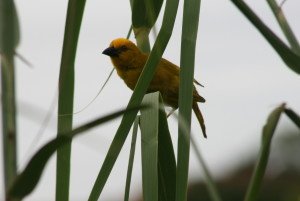Zimbali
Zimbali is unlike most other coastal resort developments in that the estate is a richly-rewarding birding spot and large enough – at 456 hectares – for many hours of twitching.
Amongst the more spectacular gems that can be spotted is a pair of breeding Crowned Eagle; and their mere presence is indicative of a natural environment comprising ecological richness and biological diversity.
Because these magnificent raptors are apex predators, it means all other links in the food chain must be intact, or else the Crowned Eagle would relocate elsewhere and certainly wouldn’t be breeding – as they have since 2001 at the luxury North Coast eco-estate.
Studies of their prey items reveal the rich biodiversity in terms of both birds and mammals found at Zimbali, which conserves patches of coastal lowland forest fringing the golf course, which is an interesting challenge when the wind is blowing.
Other specials which one can certainly expect to see at Zimbali include the endearing Goldenrumped Tinker Barbet and the attractive Redbacked Mannikin, which is restricted to the eastern borders of South Africa.
A pair of African Fish Eagle are the other prominent raptors to be spotted at Zimbali, lording it over the open waters, while there are also a few Yellowbilled Kite around in summer and Longcrested Eagle is becoming more regular at the conservancy.
The Eastern Olive Sunbird is a typical forest bird present at Zimbali, along with Collared Sunbird, White-Eared and Blackcollared Barbet, Natal Robin, Greenbacked Camaroptera, Thickbilled Weaver and Yellowbellied Bulbul.
The secluded nature of some of the walks around Zimbali lend themselves to sightings of the shyer Horus Swift, while the riparian vegetation along the Zimbali River is just to the liking of the Yellow Weaver.
Pied Kingfisher hover-hunt over the ponds on the course, where Goliath Heron also go fishing, while African Jacana strut around the water grasses.
In the woodlands, one may see Plumcoloured Starling, Natal Francolin and Whitebrowed Scrub Robin.
Sightings list
Yellowbilled Kite
African Fish Eagle
Southern Greyheaded Sparrow
Vervet Monkey
European Swallow
Lesser Striped Swallow
Blackeyed Bulbul
Eastern Olive Sunbird
Blackheaded Oriole
Redeyed Dove
Bronze Mannikin
Forktailed Drongo
Redwinged Starling
Whitebreasted Cormorant
Pied Crow
Feral Pigeon
Palm Swift
Common Myna
Hadeda Ibis
Collared Sunbird
Burchell’s Coucal
Cape Wagtail
Horus Swift
White-Eared Barbet
Blacksmith Plover
Longcrested Eagle
Bushbuck
African Pied Wagtail
Fiscal Shrike
Yellow Weaver
Plumcoloured Starling
Redbacked Mannikin
Egyptian Goose
Natal Robin
Little Swift
Goliath Heron
Blackheaded Heron
Greenbacked Cameroptera
Natal Francolin
Pied Kingfisher
Southern Red Bishop
African Jacana
Crowned Eagle
Blackcollared Barbet
Spottedbacked Weaver
Hamerkop
Speckled Mousebird
Thickbilled Weaver
Goldenrumped Tinker Barbet
Tawnyflanked Prinia
Whitebrowed Scrub Robin
Yellowbellied Bulbul
